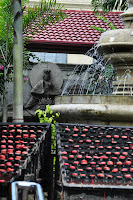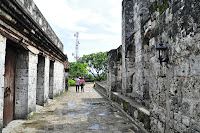Day 8: Cebu
 We waited for our room-upgrade the next day before going on to our city tour. The hotel guard hailed a taxi for us and immediately took note of the taxi's plate number etc. then gave us the paper with its details. It was not much use for me since the drivers do whatever they want. We were already inside when the driver insisted that we pay 750 pesos instead of the 600 that was agreed. It did not make much sense for me to make such a fuss for the 150 pesos (ca. 2€) extra. Reporting it to the Land Transportation Office would just take much of my precious time and energy. Going down and hailing another cab was not an option at the time.
We waited for our room-upgrade the next day before going on to our city tour. The hotel guard hailed a taxi for us and immediately took note of the taxi's plate number etc. then gave us the paper with its details. It was not much use for me since the drivers do whatever they want. We were already inside when the driver insisted that we pay 750 pesos instead of the 600 that was agreed. It did not make much sense for me to make such a fuss for the 150 pesos (ca. 2€) extra. Reporting it to the Land Transportation Office would just take much of my precious time and energy. Going down and hailing another cab was not an option at the time.
 We waited for our room-upgrade the next day before going on to our city tour. The hotel guard hailed a taxi for us and immediately took note of the taxi's plate number etc. then gave us the paper with its details. It was not much use for me since the drivers do whatever they want. We were already inside when the driver insisted that we pay 750 pesos instead of the 600 that was agreed. It did not make much sense for me to make such a fuss for the 150 pesos (ca. 2€) extra. Reporting it to the Land Transportation Office would just take much of my precious time and energy. Going down and hailing another cab was not an option at the time.
We waited for our room-upgrade the next day before going on to our city tour. The hotel guard hailed a taxi for us and immediately took note of the taxi's plate number etc. then gave us the paper with its details. It was not much use for me since the drivers do whatever they want. We were already inside when the driver insisted that we pay 750 pesos instead of the 600 that was agreed. It did not make much sense for me to make such a fuss for the 150 pesos (ca. 2€) extra. Reporting it to the Land Transportation Office would just take much of my precious time and energy. Going down and hailing another cab was not an option at the time.
The first destination was to the Taoist temple which is located in an exclusive subdivision on the hills overlooking the city. Our cab driver brought us next to the gates and waited there for us. The Taoist Temple was quite an impressive facility with an equally remarkable architecture where we have taken a lot of photographs. There is the view of the city and the sea. The intermittent downpour added to the ambience.
Built in 1972, the Cebu Taoist Temple is located in Beverly Hills Subdivision in Cebu City, Philippines. The temple was built by Cebu's substantial[1] Chinese community. With an elevation of 300 meters above sea level, the temple is a towering, multi-tiered, multi-hued attraction accessible by three separate winding routes.
Unlike the neighboring Phu Sian Temple[2], the Taoist temple is open to the worshipers and non-worshipers alike. A ritual among devotees is where one prays to the gods to grant one's wish. The ritual includes washing of hands, going inside the chapel barefoot and dropping two blocks of wood. If the blocks of wood are both face up then one could make a wish. If not then it is not yet the time for one's wish to be granted and one has to come to the temple some other time.
The temple is the center of worship for Taoism, the religion which follows the teachings of the ancient Chinese philosopher, Lao Tze. Another ritual among Taoist devotees, which is done during Wednesdays and Sundays,[3] is the climbing of its 81 steps (representing the 81 chapters of Taoism scriptures) to light joss sticks and have their fortune read by the monks.
We then let our cab driver bring us to the next stop at Casa Gorordo Museum, where you get a glimpse of the aristocratic life in Cebu during the 19th century. From there, we continued on foot passing by a bakery where we made a shortstop, then passing by around the corner is the somewhat run-down Yap-San Diego ancestral house. Then we went to "the heritage of Cebu monument" which was only a few minutes walk away.
From the monument, however, we came to a busy street, chaotic and full which is typical of an urban area. The road looks safe enough though but it's not necessarily relaxing to walk around there. The next stop was to the Basilica del Santo Niño, at least that's what we thought, but it was the Cebu Metropolitan Cathedral. We had a moment's pause in its garden just to absorb what we have all been seeing.
We finally came to the right basilica. It was really crowded with countless women who are selling candles and other religious and devotional paraphernalia. I just took some photographs, but we didn't stay long in a mad crowd.
The image of Santo Niño de Cebú (Holy Child of Cebu), the oldest Christian image in the Philippines, is enshrined and venerated at the Basilica of Santo Niño. According to Philippine historical documents, the statue of the Santo Niño (Holy Child) was given to the wife of the Rajah of Cebu by the Portuguese explorer Ferdinand Magellan. The friendship is depicted in Cebu's cultural event, the Sinulog where street parades and loud drum beats preceded by a Christian mass is celebrated. Cebu has a Roman Catholic Archdiocese and has several major churches, including the Basilica Minor del Santo Niño de Cebu, Cebu Metropolitan Cathedral, Santo Rosario Parish Church, San José-Recoletos Church, Sacred Heart Church, Archdiocesan Shrine of Our Lady of Lourdes, National Shrine of Our Lady of the Rule, National Shrine of Saint Joseph, Archdiocesan Shrine of Our Lady of Guadalupe of Cebu and other Christian churches, as well as several other non-Catholic churches, mosques and temples.
We went to Magellan's Cross next. The cross was said to be the original cross planted by Magellan during his Christianization of the islands.
Then we had enough and decided to go to our last stop, the Fort San Pedro which lies a bit away from the madness of the city. It is located in the area now called Plaza Independenzia. The fort was probably the next impressive attraction after the Taoist temple in Cebu city. One can go up and around the fort. After that, we took a cab back to the hotel.
Since we wanted to eat dinner, we ventured to SM Mall, a vast and modern shopping centre with many excellent restaurants to suit every taste and budget. It was, however, the first and only time that we walked as I have insisted on going on foot. The mall was just about 10 minutes from the hotel, but then we suddenly found ourselves walking in the middle of a slum area. These were already heavily dilapidated dwellings (huts would be an exaggeration), with many people on the street. We were just too happy to finally reach the end of this long muddy road and the mall.
The mall was modern and apt to western standards. It is air-conditioned, and we took advantage of the chance to pick up some new shirts after the heat had already ensured that our selection of fresh clothes was low. We argued however in which restaurant we would eat. My companion prevailed on eating fried chicken which he eventually never liked.
Then we took a cab back to the hotel.
















































No comments:
Post a Comment